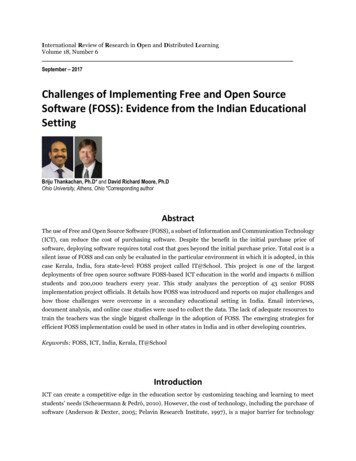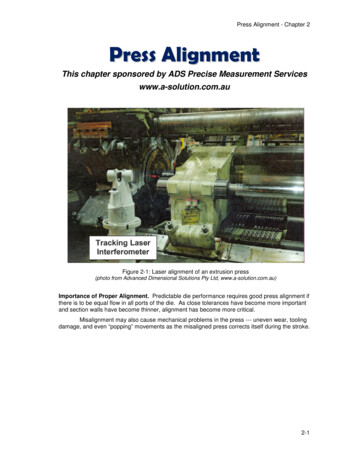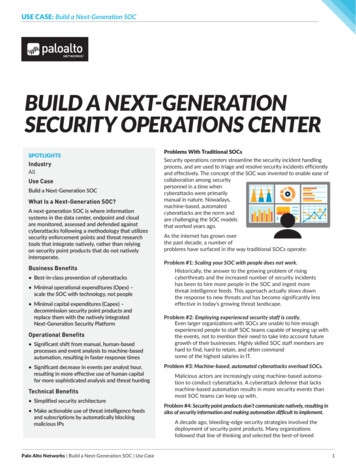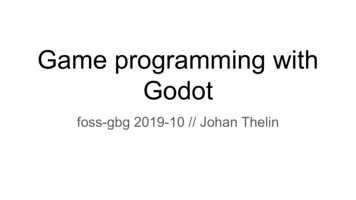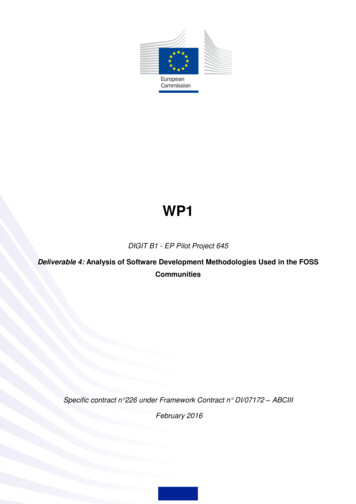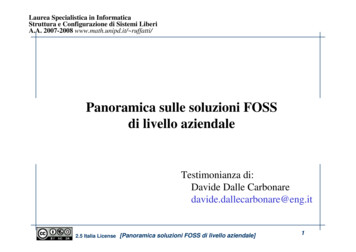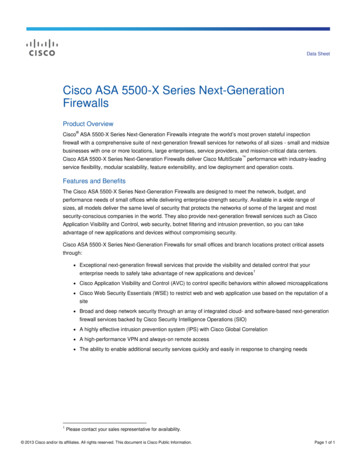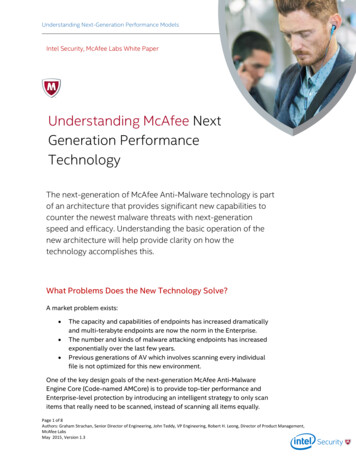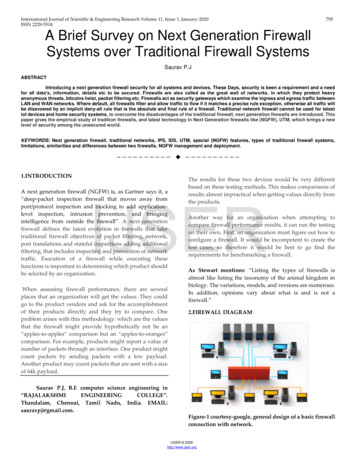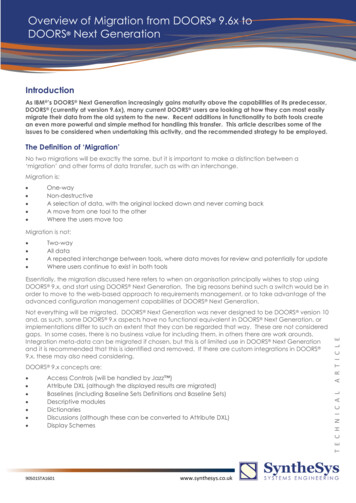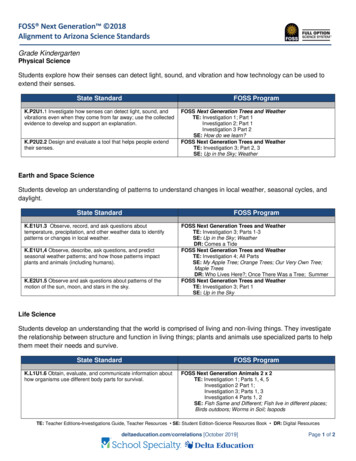
Transcription
FOSS Next Generation 2018Alignment to Arizona Science StandardsGrade KindergartenPhysical ScienceStudents explore how their senses can detect light, sound, and vibration and how technology can be used toextend their senses.State StandardK.P2U1.1 Investigate how senses can detect light, sound, andvibrations even when they come from far away; use the collectedevidence to develop and support an explanation.K.P2U2.2 Design and evaluate a tool that helps people extendtheir senses.FOSS ProgramFOSS Next Generation Trees and WeatherTE: Investigation 1; Part 1Investigation 2; Part 1Investigation 3 Part 2SE: How do we learn?FOSS Next Generation Trees and WeatherTE: Investigation 3; Part 2, 3SE: Up in the Sky; WeatherEarth and Space ScienceStudents develop an understanding of patterns to understand changes in local weather, seasonal cycles, anddaylight.State StandardK.E1U1.3 Observe, record, and ask questions abouttemperature, precipitation, and other weather data to identifypatterns or changes in local weather.K.E1U1,4 Observe, describe, ask questions, and predictseasonal weather patterns; and how those patterns impactplants and animals (including humans).K.E2U1.5 Observe and ask questions about patterns of themotion of the sun, moon, and stars in the sky.FOSS ProgramFOSS Next Generation Trees and WeatherTE: Investigation 3; Parts 1-3SE: Up in the Sky; WeatherDR: Comes a TideFOSS Next Generation Trees and WeatherTE: Investigation 4; All PartsSE: My Apple Tree; Orange Trees; Our Very Own Tree;Maple TreesDR: Who Lives Here?; Once There Was a Tree; SummerFOSS Next Generation Trees and WeatherTE: Investigation 3; Part 1SE: Up in the SkyLife ScienceStudents develop an understanding that the world is comprised of living and non-living things. They investigatethe relationship between structure and function in living things; plants and animals use specialized parts to helpthem meet their needs and survive.State StandardK.L1U1.6 Obtain, evaluate, and communicate information abouthow organisms use different body parts for survival.FOSS ProgramFOSS Next Generation Animals 2 x 2TE: Investigation 1; Parts 1, 4, 5Investigation 2 Part 1;Investigation 3; Parts 1, 3Investigation 4 Parts 1, 2SE: Fish Same and Different; Fish live in different places;Birds outdoors; Worms in Soil; IsopodsTE: Teacher Editions-Investigations Guide, Teacher Resources SE: Student Edition-Science Resources Book DR: Digital Resourcesdeltaeducation.com/correlations [October 2019]Page 1 of 2
FOSS Next Generation 2018Alignment to Arizona Science StandardsGrade KindergartenK.L1U1.7 Observe, ask questions, and explain how specializedstructures found on a variety of plants and animals (includinghumans) help them sense and respond to their environment.K.L2U1.8 Observe, ask questions, and explain the differencesbetween the characteristics of living and non-living things.FOSS Next Generation Trees and WeatherTE: Investigation 1: Part 1Investigation 4 Part 7 ,9SE: Maple TreesDR: SummerFOSS Next Generation Animals 2 x 2TE: Investigation 2: Part 3SE: Water and Land SnailsFOSS Next Generation Trees and WeatherTE: Investigation 1: Parts 5, 6SE: Where do trees go? What do plants need?Trade Book: A Tree Comes to ClassFOSS Animals 2 x 2TE: Investigation 4: Part 4SE: Living and NonlivingTrade Book Animals 2 x 2DR: Find the ParentSTEM EngineeringEngineering is a systematic and often iterative approach to designing objects, processes, and systems to meethuman needs and wants. This includes defining and delimiting an engineering problem, developing possiblesolutions and optimizing the design solution. (A Framework for K-12 Science Education: Practices,Crosscutting Concepts, and Core Ideas. (2012). Washington: The National Academies Press. p. 202-203).State StandardCore Idea U2 The knowledge produced by science is used inengineering and technologies to solve problems and/or createproducts.FOSS ProgramFOSS Next Generation Materials and MotionTE: Investigation 1, Parts 1,6, 7Investigation 2, Parts 2,4, 5Investigation 3, Part 6Investigation 4, Part 2SE: Are you an Engineer? The Story of a Chair; The Storyof a BoxDR: Roller Coaster BuilderFOSS Next Generation Trees and WeatherTE: Investigation 3, Part 3SE: WeatherDR: Come a TideTE: Teacher Editions-Investigations Guide, Teacher Resources SE: Student Edition-Science Resources Book DR: Digital Resourcesdeltaeducation.com/correlations [October 2019]Page 2 of 2
FOSS Next Generation 2018Alignment to Arizona Science StandardsGrade 1Physical ScienceStudents develop an understanding of the effects of forces and waves, and how they can impact or be impactedby objects near and far away. They explore the relationships between sound and vibrating materials, as wellas, light and materials including the ability of sound and light to travel from place to place.State StandardFOSS Program1.P2U1.1 Plan and carry out investigations demonstrating theeffect of placing objects made with different materials in the pathof a beam of light and predict how objects with similarproperties will affect the beam of light.1.P2U1.2 Use models to provide evidence that vibrating mattercreates sound and sound can make matter vibrate.FOSS Next Generation Sound and LightTE: Investigation 3; All PartsInvestigation 4; All PartsSE: Playing in the Light; Reflections, Seeing the LightDR: All about Light; Light and Shadows; My ShadowFOSS Next Generation Sound and LightTE: Investigation 1; All PartsInvestigation 2; All PartsSE: Vibration and Sound; Listen to This; Animal Ears andHearing; Listen to ThisDR: Sorting Sounds; Sorting CardsFOSS 3rd Edition Balance and MotionTE: Investigation 4, All PartsSE: Strings in Motion1.P3U1.3 Plan and carry out investigations which demonstratehow equal forces can balance objects and how unequal forcescan push, pull, twist objects, making them change their speed,direction, or shape.1.P4U2.4 Design and evaluate ways to increase or reduce heatfrom friction between two objects.FOSS 3rd Edition Balance and MotionTE: Investigations 1-4, All PartsSE: Make it Balance, Push or Pull, Things that Spin,Rolling, Rolling, Rolling,DR: Roller Coaster Builder; All about Simple MachinesFOSS 3rd Edition Balance and MotionTE: Investigation 2, Part 3SE: Tools and Machines, All about Simple MachinesEarth and Space ScienceStudents develop an understanding that organisms depend on earth materials and other organisms for survival.State StandardFOSS Program1.E1U1.5 Obtain, evaluate, and communicate information aboutthe properties of Earth materials and investigate the properties ofearth materials and how humans use resources in everyday life.FOSS Next Generation Insects and PlantsTE: Investigation 1, Parts 1-2Investigation 3, Part 2Investigation 5, Part 4SE: Animals and Plants in Their HabitatsDR: Habitat Havoc, What is PollinationNote: This will be extended in Grade 2 Pebbles, Sand and SiltInvestigation 3.Life ScienceStudents develop an understanding that the Earth has supported, and continues to support, a large variety oforganisms. These organisms can be distinguished by their physical characteristics, life cycles, and theirdifferent resource needs for survival. Different types of organisms live where there are different earth resourcessuch as food, air and water.TE: Teacher Editions-Investigations Guide, Teacher Resources SE: Student Edition-Science Resources Book DR: Digital Resourcesdeltaeducation.com/correlations [June 2019]Page 1 of 3
FOSS Next Generation 2018Alignment to Arizona Science StandardsGrade 1State StandardFOSS Program1.L1U1.6 Observe, describe, and predict life cycles of animalsand plants1.L2U2.7 Develop and use models about how living things useresources to grow and survive; design and evaluate habitats fororganisms using earth materials.1.L2U1.8 Construct an explanation describing how organismsobtain resources from the environment including materials thatare used again by other organisms.1.L3U1.9 Obtain, evaluate, and communicate information tosupport an evidence-based explanation that plants and animalsproduce offspring of the same kind, but offspring are generallynot identical to each other or their parents1.L4U1.10 Develop a model to describe how animals and plantsare classified into groups and subgroups according to theirsimilarities.1.L4U3.11 Ask questions and explain how factors can causespecies to go extinct.FOSS Next Generation Insects and PlantsTE: Investigations 1-5, All PartsSE: Flowers and Seeds; Insect Life CyclesDR: How Seeds get here and there?FOSS Next Generation Insects and PlantsTE: Investigation 3, Part 3Investigation 4, Part 2SE: Animals and Plants in their Habitats;DR: Habitat Gallery; Where Does It Live; OrganismsMatch; Habitat HavocFOSS Next Generation Insects and PlantsTE: Investigations 1-5; All PartsSE: Animals and Plants in their Habitats; So Many Kinds,So Many PlacesDR: What Doesn’t BelongFOSS Next Generation Insects and PlantsTE: Investigation 1, Part 3Investigation 5, Part 3SE: Insects Shapes and Colors; So Many Kinds, So ManyPlacesDR: Live Goes AroundFOSS Next Generation Insects and PlantsTE: Investigation 3, Part 2, 4Investigation 4, Part 2Investigation 5, Part 3SE: Insects Shapes and Colors; So Many Kinds, So ManyPlacesDR: Insects; Insect Hunt; House and Backyard, Insects;Watch it Grow, What Doesn’t BelongFOSS Next Generation Insects and PlantsTE: Investigation 1, Part 3; Steps 7 and 13Investigation 3, Part 2; Steps 17-18Investigation 4, Part 4DR: Habitat HavocNote: This can be extended with online tutorials from grade 3FOSS Next Generation Structures of Life Grade 3 Tutorials:Basic Plant Needs; Basic Animal Needs.TE: Teacher Editions-Investigations Guide, Teacher Resources SE: Student Edition-Science Resources Book DR: Digital Resourcesdeltaeducation.com/correlations [June 2019]Page 2 of 3
FOSS Next Generation 2018Alignment to Arizona Science StandardsGrade 1STEM EngineeringEngineering is a systematic and often iterative approach to designing objects, processes, and systems to meethuman needs and wants. This includes defining and delimiting an engineering problem, developing possiblesolutions and optimizing the design solution (A Framework for K-12 Science Education: Practices, CrosscuttingConcepts, and Core Ideas. (2012). Washington: The National Academies Press. p. 202-203).State StandardFOSS ProgramCore Idea U2: The knowledge produced by science is used inengineering and technologies to solve problems and/or createproducts.FOSS Next Generation Sound and LightTE: Investigation 2, Part 4Investigation 4, Part 4SE: Communicating with LightFOSS 3rd Edition Balance and MotionTE: Investigation 3, Part 3DR: Roller Coaster BuildingFOSS Next Generation Insects and PlantsTE: Investigation 4, Part 2Investigation 5, Part 2TE: Teacher Editions-Investigations Guide, Teacher Resources SE: Student Edition-Science Resources Book DR: Digital Resourcesdeltaeducation.com/correlations [June 2019]Page 3 of 3
FOSS Next Generation 2018Alignment to Arizona Science StandardsGrade 2Physical ScienceStudents develop an understanding of observable properties of matter and how changes in energy (heating orcooling) can affect materials.State StandardFOSS Program2.P1U1.1 Plan and carry out an investigation to determine thatmatter has mass, takes up space, and is recognized by itsobservable properties; use the collected evidence to developand support an explanation.2.P1U1.2 Plan and carry out investigations to gather evidence tosupport an explanation on how heating or cooling can cause aphase change in matter.2.P4U1.3 Obtain, evaluate and communicate information aboutways heat energy can cause change in objects or materials.FOSS Next Generation Solids and LiquidsTE: Investigation 1, Parts 1-4Investigation 2 and 3, all Parts;Investigation 4, Parts 1-3SE: Everything Matters, Solid Objects and Materials,Towers, Bridges, Liquids, Pouring, Mix It Up!DR: Clothing and Building Materials, Properties ofMaterials, All About Properties of Matter, Falling BottlePuzzle, Comparing Solids and LiquidsFOSS Next Generation Air and WeatherTE: Investigation 1, All PartsSE: Air is There; What is All Around UsDR: Friction and Air ResistanceFOSS Next Generation Solids and LiquidsTE: Investigation 4, Part 3SE: Heating and Cooling, Is Change Reversible?DR: Solids and Liquids, Change It!FOSS Next Generation Solids and LiquidsTE: Investigation 4, Part 3SE: Heating and Cooling, Is Change Reversible?DR: Solids and Liquids, Change It!Earth and Space ScienceStudents develop an understanding of the distribution and role of water and wind in weather, shaping the land,and where organisms live. Wind and water can also change environments, and students learn humans andother organisms can change environments too. Students develop an understanding of changing patterns in thesky including the position of Sun, Moon, and stars, and the apparent shape of the Moon.State StandardFOSS Program2.E1U1.4 Observe and investigate how wind and water changethe shape of the land resulting in a variety of landforms.FOSS Next Generation Pebbles, Sand, and SiltTE: Investigation 1, Part 2Investigation 2, Parts 2 and 4Investigation 4, Parts 2 and 4SE: The Story of Sand, Rocks Move, Landforms, Where isWater Found?. What is in Soil?, Testing Soil. Erosion,Ways to Represent Land and WaterDR: All About Volcanoes, All about Soil, All aboutLandformsFOSS Next Generation Air and WeatherTE: Investigation 3, All PartsSE: Understanding WeatherDR: Wind SpeedTE: Teacher Editions-Investigations Guide, Teacher Resources SE: Student Edition-Science Resources Book DR: Digital Resourcesdeltaeducation.com/correlations [June 2019]Page 1 of 3
FOSS Next Generation 2018Alignment to Arizona Science StandardsGrade 22.E1U1.5 Develop and use models to represent that water canexist in different states and is found in oceans, glaciers, lakes,rivers, ponds, and the atmosphere.2.E1U2.6 Analyze patterns in weather conditions of variousregions of the world and design, test, and refine solutions toprotect humans from severe weather conditions.2.E1U3.7 Construct an argument from evidence regardingpositive and negative changes in water and land systems thatimpact humans and the environment.2.E2U1.8 Observe and explain the Sun’s position at differenttimes during a twenty-four-hour period and changes in theapparent shape of the Moon from one night to another.FOSS Next Generation Pebbles, Sand, and SiltTE: Investigation 4, Part 3 and 4SE: Where is Water Found?, States of Water, Ways toRepresent Land and WaterFOSS Next Generation Pebbles, Sand, and SiltTE: Investigation 4, Part 4SE: ErosionDR: All About LandformsFOSS Next Generation Air and WeatherTE: Investigation 2, Parts 1-3Investigation 3, Parts 1-3Investigation 4, Parts 1 and 3SE: What is all Around Us?, What is the Weather Today?,Clouds, Water in the Air, Understanding the Weather,Seasons, Getting through the WinterDR: Cloud Catcher, Wind Speed, What’s the Weather?FOSS Next Generation Pebbles, Sand, and SiltTE: Investigation 4, Part 2SE: What is in the Soil?, Testing Soil, Where is WaterFound?, States of Water, ErosionDR: All About Soil, All about LandformsFOSS Next Generation Air and WeatherTE: Investigation 2, Part 4Investigation 4, Part 1 and 2SE: Changes in the SkyLife ScienceStudents develop an understanding that life on Earth depends on energy from the Sun or energy fromother organisms to survive.State StandardFOSS Program2.L2U1.9 Obtain, analyze, and communicate evidence thatorganisms need a source of energy, air, water, and certaintemperature conditions to survive.2.L2U1.10 Develop a model representing how life on Earthdepends on energy from the Sun and energy from otherorganisms.FOSS Next Generation Plants and AnimalsTE: Investigations 1, 2, 3, and 4, All PartsSE: What Do Plants Need?, The Story of Wheat, Variation,What Do Animals Need?, Plants and Animals Around theWorld, Learning from Nature, Animals and Their YoungDR: How Plants Grow, Animal Growth, How Plants Live inDifferent Places, Animal Growth, Sorting Animals byStructures, Habitat Sort, Animal Offspring and Caring forAnimals, Watch it Grow!, Find the ParentFOSS Next Generation Plants and AnimalsTE: Investigation 1, All PartsInvestigation 3, All PartsSE: What Do Plants Need?, The Story of Wheat, Variation,What Do Animals Need?, Plants and Animals Around theWorld, Learning from NatureDR: How Plants Grow, Animal Growth, How Plants Live inDifferent Places, Animal Growth, Sorting Animals byStructures, Habitat SortTE: Teacher Editions-Investigations Guide, Teacher Resources SE: Student Edition-Science Resources Book DR: Digital Resourcesdeltaeducation.com/correlations [June 2019]Page 2 of 3
FOSS Next Generation 2018Alignment to Arizona Science StandardsGrade 2STEM EngineeringEngineering is a systematic and often iterative approach to designing objects, processes, and systems to meethuman needs and wants. This includes defining and delimiting an engineering problem, developing possiblesolutions and optimizing the design solution. (A Framework for K-12 Science Education: Practices, CrosscuttingConcepts, and Core Ideas. (2012). Washington: The National Academies Press. p. 202-203).Core Idea for Using Science State StandardCore Idea U2: The knowledge produced by science is used inengineering and technologies to solve problems and/or createproducts.FOSS ProgramFOSS Next Generation Air and WeatherTE: Investigation 1, Part 2SE: What is All Around Us?DR: Friction and Air ResistanceFOSS Next Generation Plants and AnimalsTE: Investigation 3, Part 1SE: What Do Animals Need?FOSS Next Generation Pebbles, Sand, and SiltTE: Investigation 2, Part 1Investigation 3, Part 3Investigation 4, Part 4FOSS Next Generation Solids and LiquidsTE:: Investigation 1, Part 4TE: Teacher Editions-Investigations Guide, Teacher Resources SE: Student Edition-Science Resources Book DR: Digital Resourcesdeltaeducation.com/correlations [June 2019]Page 3 of 3
FOSS Next Generation 2018Alignment to Arizona Science StandardsGrade 3Physical ScienceStudents develop an understanding of the sources, properties, and characteristics of energy along with therelationship between energy transfer and the human body.State StandardFOSS Program3.P2U1.1 Ask questions and investigate the relationshipbetween light, objects, and the human eye.3.P1U1.2 Plan and carry out an investigation to explore howsound waves affect objects at varying distances.3.P4U1.3 Develop and use models to describe how light andsound waves transfer energy.FOSS Next Generation EnergyTE: Investigation 5, Part 2SE: Light Interactions; Throw a little Light on Sight; MoreLight on the SubjectDR: All about Light; Reflecting Light; Colored Light; VirtualInvestigation: ColorFOSS Sound Design Coming Soon!FOSS Sound Design Coming Soon!FOSS Next Generation EnergyTE: Investigation 5, Parts 1, 3SE: Waves, More about Sound, Alternative Sources ofEnergy, ElectricityDR: Sound Energy, WavesEarth and Space Science.Students develop an understanding of how the Sun provides light and energy for Earth systems.State StandardFOSS Program3.E1U1.4 Construct an explanation describing how the Sun isthe primary source of energy impacting Earth systems.FOSS Next Generation Structures of LifeTE: Investigation 2, Parts 1-2Investigation 3, Part 1SE: Germination, Life Cycles, Life on Earth, A Change inthe EnvironmentDR: How Plants Get Food, All About Animal Life Cycles,Structure and Function of Plants, Habitat Gallery,Organisms MatchLife ScienceStudents develop an understanding of the flow of energy in a system beginning with the Sun to and amongorganisms They also understand that plants and animals (including humans) have specialized internal andexternal structures and can respond to stimuli to increase survival.State StandardFOSS Program3.L1U1.5 Develop and use models to explain that plants andanimals (including humans) have internal and external structuresthat serve various functions that aid in growth, survival, behavior,and reproduction.FOSS Next Generation Structures of LifeTE: Investigations 1, 2, 3, and 4, All PartsSE: The Reason for Fruit, The Most Important Seed,Nature Journal-How Seeds Travel, Germination, LifeCycles, Adaptations, A Change in the Environment, TheHuman Skeleton, Skeletons on the Outside Crayfish SnailsTE: Teacher Editions-Investigations Guide, Teacher Resources SE: Student Edition-Science Resources Book DR: Digital Resourcesdeltaeducation.com/correlations [June 2019]Page 1 of 2
FOSS Next Generation 2018Alignment to Arizona Science StandardsGrade 33.L2U1.6 Plan and carry out investigations to demonstrate waysplants and animals react to stimuli.3.L2U1.7 Develop and use system models to describe the flowof energy from the sun to and among living organisms.3.L2U1.8 Construct an argument from evidence that organismsare interdependent.and Humans, Your Amazing Opposable Thumbs, Jointsand MusclesDR: How Seeds Get Here and There, Plants’ Basic NeedsHow Plants Get Food, All About Animal Life Cycles,Structure and Function of Plants, All About AnimalAdaptations, Animals’ Basic Needs, Crayfish vs Snail vsMantis, Habitat Gallery, All about Fossils, Mr. BonesFOSS Next Generation Structures of LifeTE: Investigation 1, All PartsInvestigation 3, All PartsSE: The Reason for Fruit, Crayfish, Adaptations, Life onEarth, A Change in Environment, Food ChainsDR: How Seeds Get Here and There, Plants’ Basic Needs,All about Animal Adaptations, All about Animal Behaviorand Communication, Animals’ Basic Needs, Walking StickSurvival, Life CyclesFOSS Next Generation Structures of LifeTE: Investigation 2, Parts 1-2Investigation 3, All PartsSE: Germination, Life Cycles, Life on Earth, A Change inthe Environment,DR: How Plants Get Food, All About Animal Life Cycles,Structure and Function of Plants, Habitat Gallery,Organisms MatchFOSS Next Generation Structures of LifeTE: Investigation 3, Parts 3 and 5SE: Crayfish, Adaptations, Life on Earth, A Change inEnvironment, Food ChainsDR: All about Animal Adaptations, All about AnimalBehavior and Communication, Animals’ Basic Needs,Walking Stick Survival, Life Cycles, Where Does it Live?What Doesn’t Belong?, Habitat GallerySTEM EngineeringEngineering is a systematic and often iterative approach to designing objects, processes, and systems to meethuman needs and wants. This includes defining and delimiting an engineering problem, developing possiblesolutions and optimizing the design solution (A Framework for K-12 Science Education: Practices, CrosscuttingConcepts, and Core Ideas. (2012). Washington: The National Academies Press. p. 202-203).State StandardFOSS ProgramCore Idea U2: The knowledge produced by science is used inengineering and technologies to solve problems and/or createproducts.FOSS Next Generation Motion and MatterTE: Investigation 3, All PartsSE: What Engineers Do, Engineering Practices, Soap BoxDerby, How Engineers and Scientists Work Together, HowMagnets Work TogetherFOSS Sound Design Coming Soon!TE: Teacher Editions-Investigations Guide, Teacher Resources SE: Student Edition-Science Resources Book DR: Digital Resourcesdeltaeducation.com/correlations [June 2019]Page 2 of 2
FOSS Next Generation 2018Alignment to Arizona Science StandardsGrade 4Physical ScienceStudents develop an understanding of how Earth’s resources can be transformed into different forms of energy.Students develop a better understanding of electricity and magnetism.State StandardFOSS Program4.P4U1.1 Develop and use a model to demonstrate how asystem transfers energy from one object to another even whenthe objects are not touching.4.P4U1.2 Develop and use a model that explains how energy ismoved from place to place through electric currents.4.P2U11.3 Develop and use a model to demonstrate magneticforces.4P4U3.4 Engage in argument from evidence on the use andimpact of renewable and nonrenewable resources to generateelectricity.FOSS Next Generation EnergyTE: Investigations 1-5, all PartsSE: Edison Sees the Light, Energy Sources, Series andParallel Circuits, Engineering a Solar Lighting System,When Magnet Meets Magnet, Magnificent MagneticModels, Make a Magnetic Compass, Electricity Createsmagnetism, Using Magnetic Fields, Morse Gets Clicking,Energy, Force and Energy, Waves, Light InteractionsDR: Lighting a Bulb, Flow of Electricity, Simple Circuits,Conductors and Insulators, Turn on the Switch, All AboutMagnets, Magnetic Poles Quiz, Virtual Electromagnets, Allabout the Transfer of Energy, Sound Energy, Real WorldScience: Sound, Virtual Investigations 3.2; Online TutorialsInv 1, 2, 3, 5FOSS Next Generation EnergyTE: Investigation 1, all PartsInvestigation 3, all PartsInvestigation 4, Part 1SE: Edison Sees the Light, Energy Sources, Series andParallel Circuits, Engineering a Solar Lighting System,electricity Creates Magnetism, Using Magnetic Fields,Electromagnets Everywhere, Morse Gets Clicking, Systemsand EnergyDR: Lighting a Bulb, Flow of Electricity, Simple Circuits,Conductors and Insulators Turn on the Switch, KitchenMagnets, Virtual Electromagnet, Energy, Online TutorialsInv 1, 4FOSS Next Generation EnergyTE: Investigation 2, all PartsInvestigation 3, all PartsSE: When Magnet Meets Magnet, Magnificent magneticModels, Make a Magnetic Compass, Electricity Createsmagnetism, Using Magnetic Fields, ElectromagnetsEverywhere, Morse Gets ClickingDR: What Sticks and What Conducts? Magnetic Poles,Magnetic Poles Quiz, Kitchen Magnets, VirtualElectromagnet, Virtual Investigations 2.1; Online TutorialsInv 2, 3FOSS Next Generation EnergyTE: Investigation 4, Part 1Investigation 5, Part 3SE: Energy, Alternative Sources of Electricity, Mr.Osgood’s Class ReportFOSS Next Generation Water and ClimateTE: Investigation 5, Part 3SE: Using the Energy of WaterFOSS Next Generation Soils, Rocks, and LandformsTE: Investigation 4, all PartsTE: Teacher Editions-Investigations Guide, Teacher Resources SE: Student Edition-Science Resources Book DR: Digital Resourcesdeltaeducation.com/correlations [June 2019]Page 1 of 4
FOSS Next Generation 2018Alignment to Arizona Science StandardsGrade 4SE: Monumental Rocks, Geoscientists at Work, MakingConcrete, Earth Materials in ArtDR: Natural Resources, Virtual Investigation: NaturalResourcesEarth and Space ScienceStudents develop an understanding of the different Earth systems and how they interact with each other. Theyunderstand how geological systems change and shape Earth and the evidence that is used to understand thesechanges. They also understand how weather, climate, and human interactions can impact the environment.State StandardFOSS Program4.E1U1.5 Use models to explain seismic waves and their effecton the Earth.4.E1U1.6 Plan and carry out an investigation to explore andexplain the interactions between Earth’s major systems and theimpact on Earth’s surface materials and processes.4.E1U1.7 Develop and/or revise a model using various rocktypes, fossil location, and landforms to show evidence thatEarth’s surface has changed over time.FOSS Next Generation Soils, Rocks, and LandformsTE: Investigation 3, Part 4SE: It Happened So Fast!DR: All About EarthquakesFOSS Next Generation EnergyTE: Investigation 5, Parts 1 and 3SE: WavesDR: Wave, All About WavesFOSS Next Generation Water and ClimateTE: Investigation 3, all PartsInvestigation 4, all PartsSE: Studying Weather, Drying Up, Surface-AreaExperiment, Condensation, The Water Cycle, ClimateRegions, Wetlands Flood Control, Conserving Water duringDroughtsDR: All About Meteorology, Weather Grapher, EvaporationExperiment, Water Cycle, All About Climate and Seasons,Climate-Regions Map, Come a Tide, Floods, Tutorials Inv3.FOSS Next Generation Soils, Rocks, and LandformsTE: Investigation 1, all PartsInvestigation 2, all PartsInvestigation 3, Parts 2-4SE: What is Soil?, Weathering, Erosion and Deposition,Landform Photo Album, Fossils Tell a Story, Pieces of aDinosaur Puzzle, The Story of Mt. Shasta, It Happened SoFast!DR: Weathering and Erosion, Soils, Weathering, WaterRetention of Soils, Weathering and Erosion, StreamTables: Slopes and Floods, Fossils, Soil Formation,Volcanoes, Topographer, Mt. St. Helens Impact, All AboutEarthquakes, Tutorials Inv 1, 2, Virtual Inv 1, 2FOSS Next Generation Soils, Rocks, and LandformsTE: Investigation 2, all PartsInvestigation 3, all PartsSE: Erosion and Deposition, Landform Photo Album,Fossils Tell a Story, Pieces of a Dinosaur Puzzle,Topographic Maps, The Story of Mt. Shasta, It HappenedSo Fast!TE: Teacher Editions-Investigations Guide, Teacher Resources SE: Student Edition-Science Resources Book DR: Digital Resourcesdeltaeducation.com/correlations [June 2019]Page 2 of 4
FOSS Next Generation 2018Alignment to Arizona Science StandardsGrade 44.E1U1.8 Collect, analyze, and interpret data to explain weatherand climate patterns.4.E1U3.9 Construct and support an evidence-based argumentabout the availability of water and its impact on life.4.E1U2.10 Define problem(s) and design solution(s) to minimizethe effects of natural hazards.DR: Weathering and Erosion, Stream Tables: Slopes andFloods, Fossils, Soil Formation, Volcanoes, Topographer,Mt. St. Helens Impact, All About Earthquakes, TutorialsInvestigations 1, 2. Virtual Investigations 1 and 2.3FOSS Next Generation Water and ClimateTE: Investigation 2, all PartsInvestigation 3, all PartsInvestigation 4, all PartsSE: Vacation Aggravation, Celsius and Fahrenheit, Water:Hot and Cold, Studying Weather, Drying Up, Surface-AreaExperiment, Condensation, The Water Cycle, ClimateRegions, Wetlands Flood Control, Conserving Water duringDroughtsDR: Measuring Temperature, Bottle Thermometer, Hot andCold-Water Density, All About Meteorology, WeatherGrapher, Evaporation Experiment, Water Cycle, All AboutClimate and Seasons, Climate-Regions Map, Come a Tide,Floods, Tutorial Inv 3FOSS Next Generation Water and ClimateTE: Investigation 1, Parts 1, 2 and 4Investigation 2, Parts 4 and 5Investigation 4, all PartsSE: A Report from the Blue Planet, Opinion and Evidence,Water Everywhere
DR: Roller Coaster Builder; All about Simple Machines 1.P4U2.4 Design and evaluate ways to increase or reduce heat from friction between two objects. FOSS 3rd Edition Balance and Motion TE: Investigation 2, Part 3 SE: Tools and Machines, All about Simple Machines Earth and Space Science
